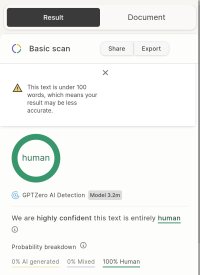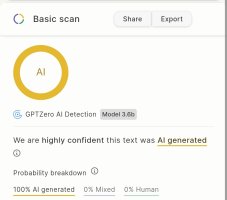TheVanishingPoint
Student
- May 20, 2025
- 197
In recent days, and in the past as well, I've noticed something curious: when I write a text in Icelandic (the language I use most) and then pass it to a translator, the AI detector completely changes its assessment. A text that I wrote as "100% human" drops to maybe 27% or 60% "AI" after translation, and sometimes it's even detected as completely artificial. Has something similar ever happened to you with your own language?
This below is an example, yet nothing has been distorted because only the translator was used.
Líknardráp er ekki afneitun lífsins heldur viðurkenning á rétti hvers einstaklings til að setja mörk eigin þjáningar. Lífið er ekki skylda og að breyta tilvist í ævilanga refsingu fyrir þann sem er fastur í líkamlegum eða andlegum sársauka er birtingarmynd grimmdar, dulbúin sem siðferði. Það er engin reisn í því að halda lífi í líkama með gerviaðferðum þegar hann hefur þegar sagt allt sem hann gat sagt, og það er ekkert kærleiksríkt við að neyða einhvern til að þrauka þegar eina óskin er að hætta. Sönn frelsi felur í sér möguleikann á að velja hvenær og hvernig kveðja á, án ótta við dóm eða refsingu. Að hafna líknardrápi þýðir að líta á manneskjuna sem eign laga eða trúarbragða en ekki sem eiganda sjálfs síns.
Euthanasia is not the denial of life but the recognition of the right of each individual to set the limits of their own suffering. Life is not a duty, and turning existence into a lifelong punishment for someone trapped in physical or mental pain is a manifestation of cruelty, disguised as morality. There is no dignity in keeping a body alive by artificial means when it has already said all it could say, and there is nothing loving in forcing someone to endure when their only wish is to end it. True freedom includes the ability to choose when and how to say goodbye, without fear of judgment or punishment. To reject euthanasia means to see the person as the property of law or religion, not as the owner of himself.
This text also obviously appears 100% human because it was written by me.

Hún sat við gluggann, horfði út á hafið þar sem öldurnar léku sér í kvöldlogninu. Hann hafði lofað að koma áður en sólinn færi til hvílu. Þegar hún heyrði létt skref nálgast, vissi hún að loforðið stæði. Hann kom inn, með saltbragð sjávarins á vörunum og bros sem ylti upp hjarta hennar. Þau sögðu fá orð; augun þeirra sögðu allt. Í þögninni milli þeirra var tónlist, í snertingu handanna var eilífð. Þau stóðu þar saman, á meðan sólin seig niður og himinninn málaðist með litum sem hvorki tími né fjarlægð gátu strokið út.
However, when the English translator is applied, it turns out to be 100% false, according to chat gbt-0 (the most reliable AI detector). You can try it.

She sat by the window, looking out at the ocean where the waves played in the evening calm. He had promised to come before the sun went down to rest. When she heard light footsteps approaching, she knew the promise was kept. He came in, with the salty taste of the sea on his lips and a smile that warmed her heart. They said few words; their eyes said everything. In the silence between them there was music, in the touch of their hands there was eternity. They stood there together, while the sun sank and the sky was painted with colors that neither time nor distance could erase.
---------
This graph demonstrates how reality can be distorted from the initial document, revealing the truth: even the so-called "most reliable" AI-based screening tool, GPTZero, can continually produce sensational fakes. It highlights the unreliability of these tools, which are increasingly used for smear and denigrating campaigns rather than constructive criticism. In the hands of some, they are machines that destroy reputations, sow doubt, and distrust without any real cause. GPTZero and other similar detectors are inadmissible as evidence in any court of law, and it's unclear why they should be admissible in other environments.
This below is an example, yet nothing has been distorted because only the translator was used.
Líknardráp er ekki afneitun lífsins heldur viðurkenning á rétti hvers einstaklings til að setja mörk eigin þjáningar. Lífið er ekki skylda og að breyta tilvist í ævilanga refsingu fyrir þann sem er fastur í líkamlegum eða andlegum sársauka er birtingarmynd grimmdar, dulbúin sem siðferði. Það er engin reisn í því að halda lífi í líkama með gerviaðferðum þegar hann hefur þegar sagt allt sem hann gat sagt, og það er ekkert kærleiksríkt við að neyða einhvern til að þrauka þegar eina óskin er að hætta. Sönn frelsi felur í sér möguleikann á að velja hvenær og hvernig kveðja á, án ótta við dóm eða refsingu. Að hafna líknardrápi þýðir að líta á manneskjuna sem eign laga eða trúarbragða en ekki sem eiganda sjálfs síns.
Euthanasia is not the denial of life but the recognition of the right of each individual to set the limits of their own suffering. Life is not a duty, and turning existence into a lifelong punishment for someone trapped in physical or mental pain is a manifestation of cruelty, disguised as morality. There is no dignity in keeping a body alive by artificial means when it has already said all it could say, and there is nothing loving in forcing someone to endure when their only wish is to end it. True freedom includes the ability to choose when and how to say goodbye, without fear of judgment or punishment. To reject euthanasia means to see the person as the property of law or religion, not as the owner of himself.
This text also obviously appears 100% human because it was written by me.

Hún sat við gluggann, horfði út á hafið þar sem öldurnar léku sér í kvöldlogninu. Hann hafði lofað að koma áður en sólinn færi til hvílu. Þegar hún heyrði létt skref nálgast, vissi hún að loforðið stæði. Hann kom inn, með saltbragð sjávarins á vörunum og bros sem ylti upp hjarta hennar. Þau sögðu fá orð; augun þeirra sögðu allt. Í þögninni milli þeirra var tónlist, í snertingu handanna var eilífð. Þau stóðu þar saman, á meðan sólin seig niður og himinninn málaðist með litum sem hvorki tími né fjarlægð gátu strokið út.
However, when the English translator is applied, it turns out to be 100% false, according to chat gbt-0 (the most reliable AI detector). You can try it.

She sat by the window, looking out at the ocean where the waves played in the evening calm. He had promised to come before the sun went down to rest. When she heard light footsteps approaching, she knew the promise was kept. He came in, with the salty taste of the sea on his lips and a smile that warmed her heart. They said few words; their eyes said everything. In the silence between them there was music, in the touch of their hands there was eternity. They stood there together, while the sun sank and the sky was painted with colors that neither time nor distance could erase.
---------
This graph demonstrates how reality can be distorted from the initial document, revealing the truth: even the so-called "most reliable" AI-based screening tool, GPTZero, can continually produce sensational fakes. It highlights the unreliability of these tools, which are increasingly used for smear and denigrating campaigns rather than constructive criticism. In the hands of some, they are machines that destroy reputations, sow doubt, and distrust without any real cause. GPTZero and other similar detectors are inadmissible as evidence in any court of law, and it's unclear why they should be admissible in other environments.
Last edited:
